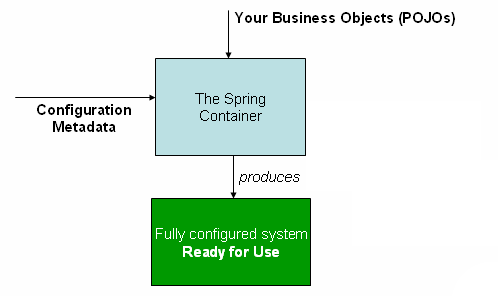Introduction to the Spring IoC container and beans
Spring Framework implementation of the Inversion of Control (IoC) [1]principle. IoC is also known as dependency injection (DI). It is a process whereby objects define their dependencies, that is, the other objects they work with, only through constructor arguments, arguments to a factory method, or properties that are set on the object instance after it is constructed or returned from a factory method. The container then injects those dependencies when it creates the bean. This process is fundamentally the inverse, hence the name Inversion of Control (IoC), of the bean itself controlling the instantiation or location of its dependencies by using direct construction of classes, or a mechanism such as the Service Locator pattern.
The
org.springframework.beans and org.springframework.context packages are the basis for Spring Framework's IoC container. The BeanFactory interface provides an advanced configuration mechanism capable of managing any type of object. ApplicationContext is a sub-interface of BeanFactory. It adds easier integration with Spring's AOP features; message resource handling (for use in internationalization), event publication; and application-layer specific contexts such as the WebApplicationContext for use in web applications.
In short, the
BeanFactory provides the configuration framework and basic functionality, and the ApplicationContext adds more enterprise-specific functionality. TheApplicationContext is a complete superset of the BeanFactory, and is used exclusively in this chapter in descriptions of Spring's IoC container. For more information on using the BeanFactory instead of the ApplicationContext, refer to Section 5.15, “The BeanFactory”.
In Spring, the objects that form the backbone of your application and that are managed by the Spring IoC container are called beans. A bean is an object that is instantiated, assembled, and otherwise managed by a Spring IoC container. Otherwise, a bean is simply one of many objects in your application. Beans, and the dependencies among them, are reflected in the configuration metadata used by a container.
5.2 Container overview
The interface
org.springframework.context.ApplicationContext represents the Spring IoC container and is responsible for instantiating, configuring, and assembling the aforementioned beans. The container gets its instructions on what objects to instantiate, configure, and assemble by reading configuration metadata. The configuration metadata is represented in XML, Java annotations, or Java code. It allows you to express the objects that compose your application and the rich interdependencies between such objects.
Several implementations of the
ApplicationContext interface are supplied out-of-the-box with Spring. In standalone applications it is common to create an instance of ClassPathXmlApplicationContext or FileSystemXmlApplicationContext. While XML has been the traditional format for defining configuration metadata you can instruct the container to use Java annotations or code as the metadata format by providing a small amount of XML configuration to declaratively enable support for these additional metadata formats.
In most application scenarios, explicit user code is not required to instantiate one or more instances of a Spring IoC container. For example, in a web application scenario, a simple eight (or so) lines of boilerplate J2EE web descriptor XML in the
web.xml file of the application will typically suffice (see Section 5.14.4, “Convenient ApplicationContext instantiation for web applications”). If you are using the SpringSource Tool Suite Eclipse-powered development environment or Spring Roo this boilerplate configuration can be easily created with few mouse clicks or keystrokes.
The following diagram is a high-level view of how Spring works. Your application classes are combined with configuration metadata so that after the
ApplicationContext is created and initialized, you have a fully configured and executable system or application.
The Spring IoC container

No comments:
Post a Comment